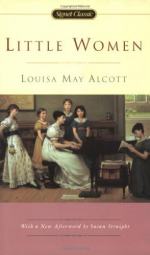|
This section contains 303 words (approx. 1 page at 400 words per page) |

|
Little Women Summary & Study Guide Description
Little Women Summary & Study Guide includes comprehensive information and analysis to help you understand the book. This study guide contains the following sections:
This detailed literature summary also contains Bibliography and a Free Quiz on Little Women by Louisa May Alcott.
Without a doubt, Little Women remains Louisa May Alcott's best-known work. Its charm and innocence continue to engage readers, despite the fact that the social and familial reality depicted is very different from contemporary domestic life. Jo March is regarded as one of the most complete, self-possessed, and best-loved characters in children's literature. In fact, many boys find that they can relate to her almost as easily as girls can. While some present-day readers find Jo and her sisters too good to be realistic, according to the standards of Alcott's society, the March girls are flawed and vulnerable. The author dared to give her characters faults such as selfishness, vanity, temper, and bashfulness qualities never seen before in such young characters.
Alcott wrote the book for girls with the sole aim of making money with its publication. After part one was published as a complete work, readers demanded to know more about the fates of the Marches. Alcott wrote Good Wives which is now published with part one as a complete work. Although the author wrote the books reluctantly, she earned the money she sought and found that her subsequent titles of all kinds were widely read. She never imagined, however, that Little Women would enchant generations of readers and become a classic of children's fiction. Critics often note that the book's particular appeal lies in its illustration of a uniquely American household and its individual members. Almost any reader can identify with at least one of the four girls. Readers are also drawn into the story by the colorful minor characters, the development of the March girls, and the attention to detail. The intricacies of education, housework, speech patterns, and manners are depicted with remarkable clarity, which better enables modern readers to envision and understand the world of the Marches.
Read more from the Study Guide
|
This section contains 303 words (approx. 1 page at 400 words per page) |

|



